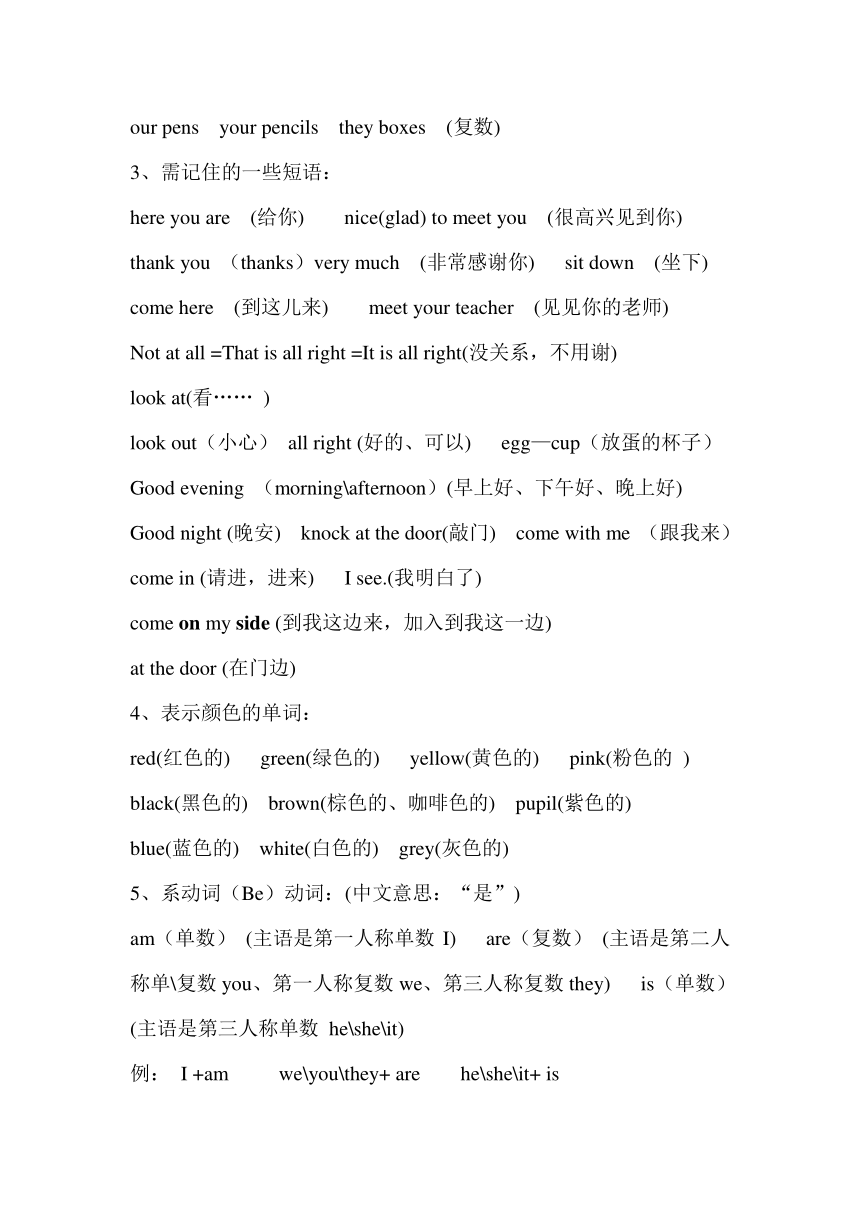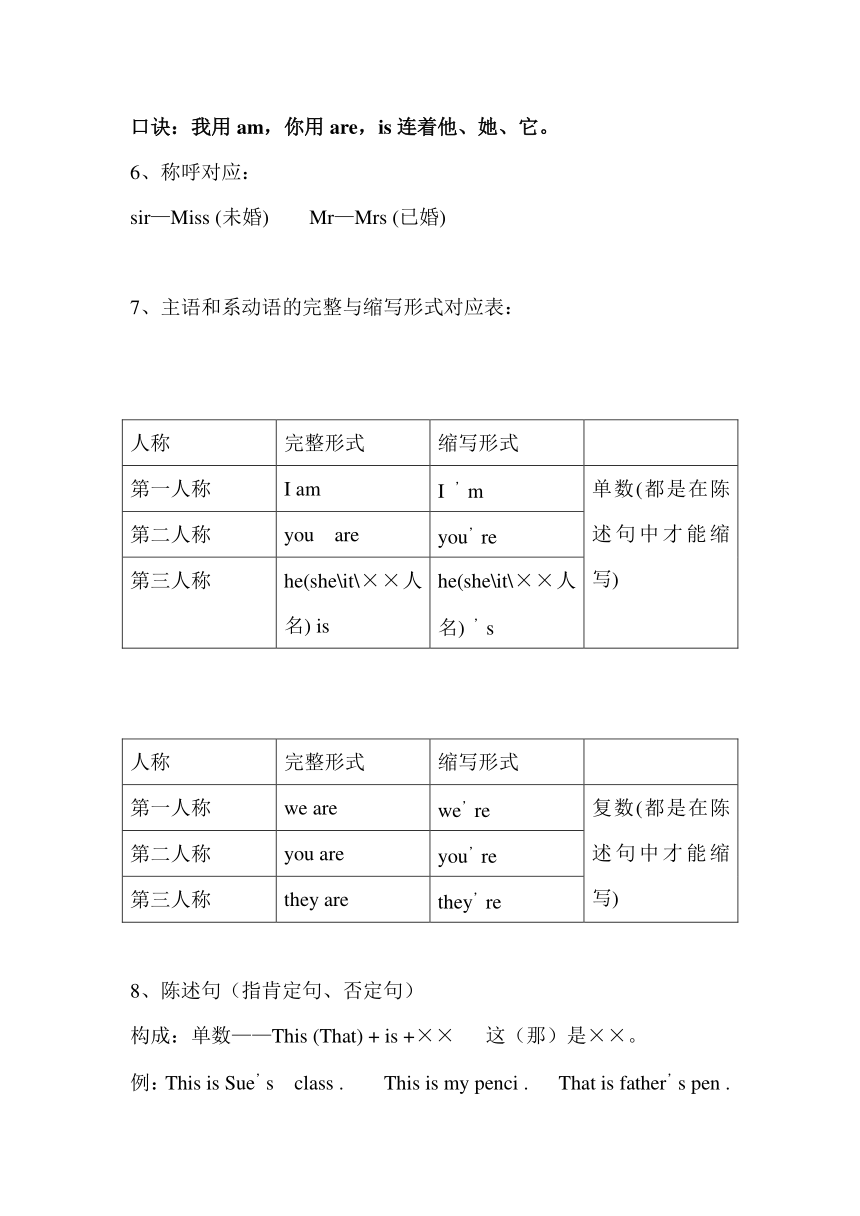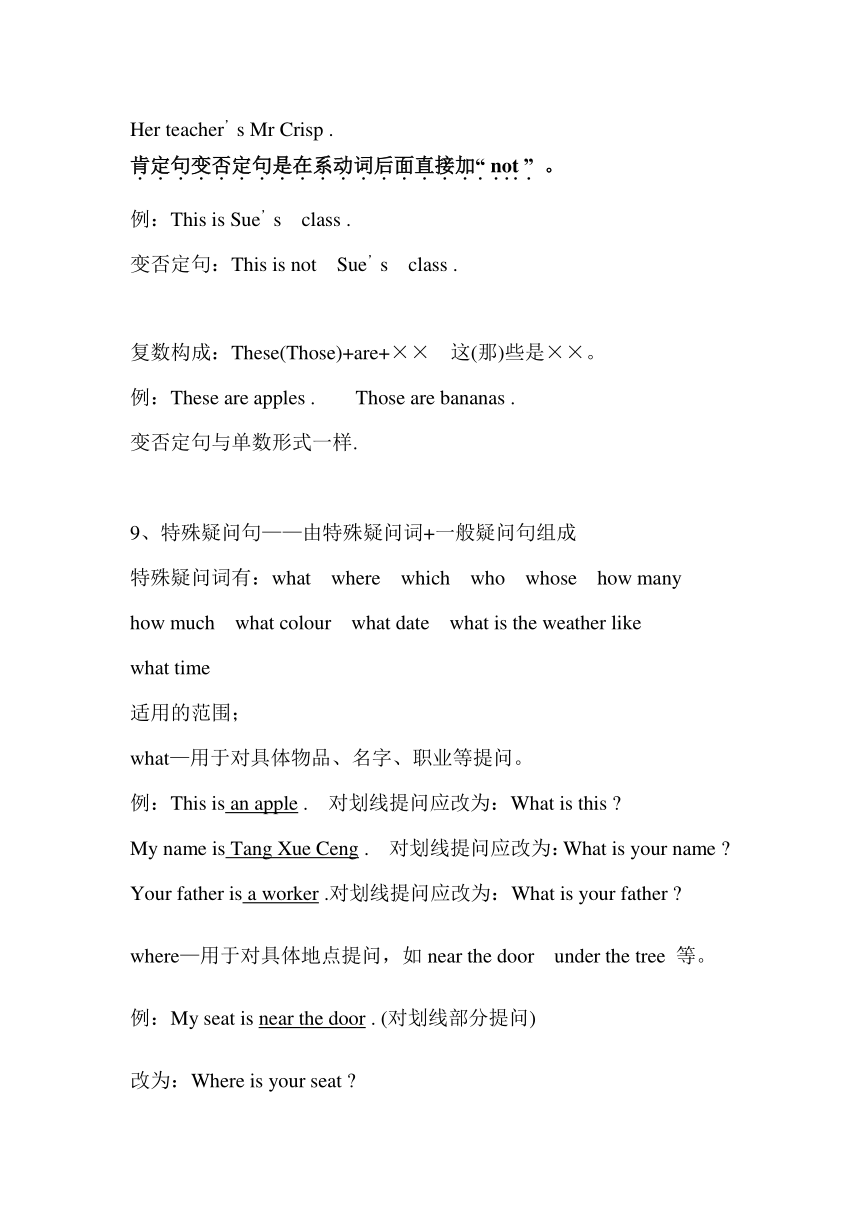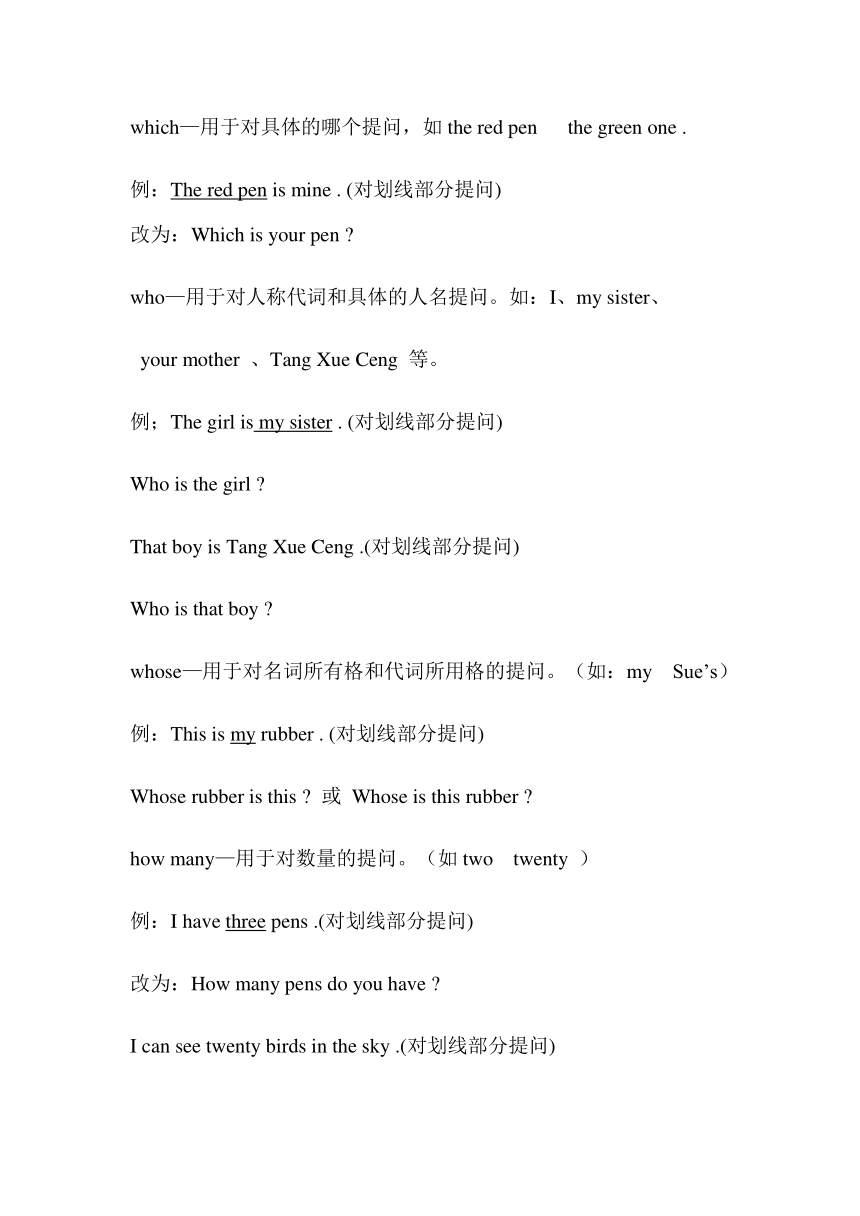3L全书每课内容归纳要点
图片预览





文档简介
3L全书每课内容归纳要点
Lesson 1
本课需掌握的知识点:
1、名词(具体人名、称呼)所有格,人名的第一个字母必须要大写。
中文:××的 英文表达:,s
例:Sue’s class、 mother’s pen
2、人称代词(指你(们)、我(们)、他(们)、它)所有格
中文:你(们)的、我(们)的、他(们)的、它的
具体英文表达见表格:
人称
主格
宾格
所有格
单数
第一人称(我)
I
me
my
第二人称(你)
you
you
your
第三人称(他、她、它)
he
him
his
she
her
her
it
it
its
人称
主格
宾格
所有格
复数
第一人称(我们)
we
us
our
第二人称(你们)
you
you
your
第三人称(他们、她们、它们)
they
them
their
例:
my pen your pencil her box his rubber its nose (单数)
our pens your pencils they boxes (复数)
3、需记住的一些短语:
here you are (给你) nice(glad) to meet you (很高兴见到你)
thank you (thanks)very much (非常感谢你) sit down (坐下)
come here (到这儿来) meet your teacher (见见你的老师)
Not at all =That is all right =It is all right(没关系,不用谢)
look at(看…… )
look out(小心) all right (好的、可以) egg—cup(放蛋的杯子)
Good evening (morningafternoon)(早上好、下午好、晚上好)
Good night (晚安) knock at the door(敲门) come with me (跟我来)
come in (请进,进来) I see.(我明白了)
come on my side (到我这边来,加入到我这一边)
at the door (在门边)
4、表示颜色的单词:
red(红色的) green(绿色的) yellow(黄色的) pink(粉色的 )
black(黑色的) brown(棕色的、咖啡色的) pupil(紫色的)
blue(蓝色的) white(白色的) grey(灰色的)
5、系动词(Be)动词:(中文意思:“是”)
am(单数) (主语是第一人称单数I) are(复数) (主语是第二人称单复数you、第一人称复数we、第三人称复数they) is(单数)(主语是第三人称单数 hesheit)
例: I +am weyouthey+ are hesheit+ is
口诀:我用am,你用are,is连着他、她、它。
6、称呼对应:
sir—Miss (未婚) Mr—Mrs (已婚)
7、主语和系动语的完整与缩写形式对应表:
人称
完整形式
缩写形式
第一人称
I am
I ,m
单数(都是在陈述句中才能缩写)
第二人称
you are
you,re
第三人称
he(sheit××人名) is
he(sheit××人名) ,s
人称
完整形式
缩写形式
第一人称
we are
we,re
复数(都是在陈述句中才能缩写)
第二人称
you are
you,re
第三人称
they are
they,re
8、陈述句(指肯定句、否定句)
构成:单数——This (That) + is +×× 这(那)是××。
例:This is Sue,s class . This is my penci . That is father,s pen .
Her teacher,s Mr Crisp .
肯定句变否定句是在系动词后面直接加“ not ” 。
例:This is Sue,s class .
变否定句:This is not Sue,s class .
复数构成:These(Those)+are+×× 这(那)些是××。
例:These are apples . Those are bananas .
变否定句与单数形式一样.
9、特殊疑问句——由特殊疑问词+一般疑问句组成
特殊疑问词有:what where which who whose how many
how much what colour what date what is the weather like
what time
适用的范围;
what—用于对具体物品、名字、职业等提问。
例:This is an apple . 对划线提问应改为:What is this ?
My name is Tang Xue Ceng . 对划线提问应改为:What is your name ?
Your father is a worker .对划线提问应改为:What is your father ?
where—用于对具体地点提问,如near the door under the tree 等。
例:My seat is near the door . (对划线部分提问)
改为:Where is your seat ?
which—用于对具体的哪个提问,如the red pen the green one .
例:The red pen is mine . (对划线部分提问) 改为:Which is your pen ?
who—用于对人称代词和具体的人名提问。如:I、my sister、
your mother 、Tang Xue Ceng 等。
例;The girl is my sister . (对划线部分提问)
Who is the girl ?
That boy is Tang Xue Ceng .(对划线部分提问)
Who is that boy ?
whose—用于对名词所有格和代词所用格的提问。(如:my Sue’s)
例:This is my rubber . (对划线部分提问)
Whose rubber is this ? 或 Whose is this rubber ?
how many—用于对数量的提问。(如two twenty )
例:I have three pens .(对划线部分提问)
改为:How many pens do you have ?
I can see twenty birds in the sky .(对划线部分提问)
改为:How many birds can you see in the sky ?
I can see twenty birds in the sky .(对划线部分提问)
改为:What can you see in the sky ?
how much—用于对价格的提问。(如:five yuan 等)
例:The shoes are fifty yuan .(对划线部分提问)
改为:How much are the shoes ?
what colour—用于对颜色的提问。(如:red 等)
例:My shoes are yellow .(对划线部分提问)
What colour are your shoes ?
what date—用于对几月几日提问。(如:3月8日等)
It is March 8th today .(对划线部分提问)
改为:What date is it today ?
what day—用于对星期几的提问。(如:星期一等)
例:It is Monday today .(对划线部分提问)
改为:What day is it today?
what is the weather (it)like—用于对天气的提问(如:sunny等)
例:It is cold in Winter .(对划线部分提问)
改为:what is the weather like in Winter ?
what nationality—用于对国籍的提问。(如中国人、法国人等)
例:I am French .(对划线部分提问)我是法国人。
What nationality are you ? (你是哪国人)?
French German Chinese English American Italian
what time—用于对时间的提问。
例:It is eight o’clock.(对划线部分提问)
改为:What time is it ?或What is the time ?
总结:所有特殊疑问句的回答不能用Yes或NO,要依据相关的实际情况来作回答。
10、一般疑问句—由系动词放句首+其他+?
构成:Is(Are)+主语+其他+?
回答:{肯定Yes, 人称代词(I we they it he she you +系动词(am are is) 否定No,人称代词+系动词+not ) .
换句话说:可将陈述句变化而来。
口诀:①将系动词提前;②其余部分照抄(但I变成you,we变成you, my变成your );③句末将句号改为问号。
例:I am a student .(变一般疑问句)
改为:Are you a student ?
This is my cap.(变一般疑问句)
改为:Is this your cap ?
11、祈使句——以动词原形开头引导的句子,Please可放在句首,也可放在句尾。(肯定句)
祈使句否定形式:直接在句首加“Do not=Don’t
例:Kick the ball,please .(肯定句)
否定句:Do not (Don’t) kick the ball,please .
12、反义词;
come—go come here—go there sit—stand sit down—stand up
yes—no hot—cold busy—free empty—full put on—take off
new—old open—close fat—thin tall—short young—oid
handsome—beautiful cleve—lazy big—small light—thick
long—short
13、用介词表示的一些用语;
The girl on the red bicycle .(骑红色自行车的那个女孩)
The boy with the football .(手里拿足球的那个男孩)
Tea is ready .(茶点准备好了) what is for tea ?茶点吃什么?
He is on his bicycle .(他骑在自行车上)
He is in his car .(他在汽车里。)
This egg is for you.(这个鸡蛋是给你吃的)
Look at my picture.(看我的画)
look at me (看着我)——介词后面一定要接人称代词的宾格。
14、名词的单、复数变化;
不规则的名词单数变复数
名词单数
名词复数
中文
woman
women
妇女
man
men
男人
child
children
孩子——孩子们
boy
boys
男孩
15、记住介词的口诀:
on在上面, in在里面, under下面, at在…… behind在…后面
next to旁边 in front of 在……前面
16、不定冠词(a an )定冠词(the)
an用于以元音音素发音(发元音字母本身音的aeiou)开始的单词前。如an egg an apple an orange
an actor an actress
17、几个同样表示“也”的单词用于不同的句式中。
“too”——用于肯定句中,一般在句子的末尾。
例:You are funy . You are funny,too.
“either”
18、“There be”句型
3L全书每课内容归纳要点
Lesson 1
本课需掌握的知识点:
1、名词(具体人名、称呼)所有格,人名的第一个字母必须要大写。
中文:××的 英文表达:,s
例:Sue’s class、 mother’s pen
2、人称代词(指你(们)、我(们)、他(们)、它)所有格
中文:你(们)的、我(们)的、他(们)的、它的
具体英文表达见表格:
人称
主格
宾格
所有格
单数
第一人称(我)
I
me
my
第二人称(你)
you
you
your
第三人称(他、她、它)
he
him
his
she
her
her
it
it
its
人称
主格
宾格
所有格
复数
第一人称(我们)
we
us
our
第二人称(你们)
you
you
your
第三人称(他们、她们、它们)
they
them
their
例:
my pen your pencil her box his rubber its nose (单数)
our pens your pencils they boxes (复数)
3、需记住的一些短语:
here you are (给你) nice(glad) to meet you (很高兴见到你)
thank you (thanks)very much (非常感谢你) sit down (坐下)
come here (到这儿来) meet your teacher (见见你的老师)
Not at all =That is all right =It is all right(没关系,不用谢)
look at(看…… )
look out(小心) all right (好的、可以) egg—cup(放蛋的杯子)
Good evening (morningafternoon)(早上好、下午好、晚上好)
Good night (晚安) knock at the door(敲门) come with me (跟我来)
come in (请进,进来) I see.(我明白了)
come on my side (到我这边来,加入到我这一边)
at the door (在门边)
4、表示颜色的单词:
red(红色的) green(绿色的) yellow(黄色的) pink(粉色的 )
black(黑色的) brown(棕色的、咖啡色的) pupil(紫色的)
blue(蓝色的) white(白色的) grey(灰色的)
5、系动词(Be)动词:(中文意思:“是”)
am(单数) (主语是第一人称单数I) are(复数) (主语是第二人称单复数you、第一人称复数we、第三人称复数they) is(单数)(主语是第三人称单数 hesheit)
例: I +am weyouthey+ are hesheit+ is
口诀:我用am,你用are,is连着他、她、它。
6、称呼对应:
sir —Miss (未婚) Mr—Mrs (已婚)
7、主语和系动语的完整与缩写形式对应表:
人称
完整形式
缩写形式
第一人称
I am
I ,m
单数(都是在陈述句中才能缩写)
第二人称
you are
you,re
第三人称
he(sheit××人名) is
he(sheit××人名) ,s
人称
完整形式
缩写形式
第一人称
we are
we,re
复数(都是在陈述句中才能缩写)
第二人称
you are
you,re
第三人称
they are
they,re
8、陈述句(指肯定句、否定句)
构成:单数——This (That) + is +×× 这(那)是××。
例:This is Sue,s class . This is my penci . That is father,s pen .
Her teacher,s Mr Crisp .
肯定句变否定句是在系动词后面直接加“ not ” 。
例:This is Sue,s class .
变否定句:This is not Sue,s class .
复数构成:These(Those)+are+×× 这(那)些是××。
例:These are apples . Those are bananas .
变否定句与单数形式一样.
9、特殊疑问句——由特殊疑问词+一般疑问句组成
特殊疑问词有:what where which who whose how many
how much what colour what date what is the weather like
what time
适用的范围;
what—用于对具体物品、名字、职业等提问。
例:This is an apple . 对划线提问应改为:What is this ?
My name is Tang Xue Ceng . 对划线提问应改为:What is your name ?
Your father is a worker .对划线提问应改为:What is your father ?
where—用于对具体地点提问,如near the door under the tree 等。
例:My seat is near the door . (对划线部分提问)
改为:Where is your seat ?
which—用于对具体的哪个提问,如the red pen the green one .
例:The red pen is mine . (对划线部分提问) 改为:Which is your pen ?
who—用于对人称代词和具体的人名提问。如:I、my sister、
your mother 、Tang Xue Ceng 等。
例;The girl is my sister . (对划线部分提问)
Who is the girl ?
That boy is Tang Xue Ceng .(对划线部分提问)
Who is that boy ?
whose—用于对名词所有格和代词所用格的提问。(如:my Sue’s)
例:This is my rubber . (对划线部分提问)
Whose rubber is this ? 或 Whose is this rubber ?
how many—用于对数量的提问。(如two twenty )
例:I have three pens .(对划线部分提问)
改为:How many pens do you have ?
I can see twenty birds in the sky .(对划线部分提问)
改为:How many birds can you see in the sky ?
I can see twenty birds in the sky .(对划线部分提问)
改为:What can you see in the sky ?
how much—用于对价格的提问。(如:five yuan 等)
例:The shoes are fifty yuan .(对划线部分提问)
改为:How much are the shoes ?
what colour—用于对颜色的提问。(如:red 等)
例:My shoes are yellow .(对划线部分提问)
What colour are your shoes ?
what date—用于对几月几日提问。(如:3月8日等)
It is March 8th today .(对划线部分提问)
改为:What date is it today ?
what day—用于对星期几的提问。(如:星期一等)
例:It is Monday today .(对划线部分提问)
改为:What day is it today?
what is the weather (it)like—用于对天气的提问(如:sunny等)
例:It is cold in Winter .(对划线部分提问)
改为:what is the weather like in Winter ?
what nationality—用于对国籍的提问。(如中国人、法国人等)
例:I am French .(对划线部分提问)我是法国人。
What nationality are you ? (你是哪国人)?
French German Chinese English American Italian
what time—用于对时间的提问。
例:It is eight o’clock.(对划线部分提问)
改为:What time is it ?或What is the time ?
总结:所有特殊疑问句的回答不能用Yes或NO,要依据相关的实际情况来作回答。
10、一般疑问句—由系动词放句首+其他+?
构成:Is(Are)+主语+其他+?
回答:{肯定Yes, 人称代词(I we they it he she you +系动词(am are is) 否定No,人称代词+系动词+not ) .
换句话说:可将陈述句变化而来。
口诀:①将系动词提前;②其余部分照抄(但I变成you,we变成you, my变成your );③句末将句号改为问号。
例:I am a student .(变一般疑问句)
改为:Are you a student ?
This is my cap.(变一般疑问句)
改为:Is this your cap ?
11、祈使句——以动词原形开头引导的句子,Please可放在句首,也可放在句尾。(肯定句)
祈使句否定形式:直接在句首加“Do not=Don’t
例:Kick the ball,please .(肯定句)
否定句:Do not (Don’t) kick the ball,please .
12、反义词;
come—go come here—go there sit—stand sit down—stand up
yes—no hot—cold busy—free empty—full put on—take off
new—old open—close fat—thin tall—short young—oid
handsome—beautiful cleve—lazy big—small light—thick
long—short
13、用介词表示的一些用语;
The girl on the red bicycle .(骑红色自行车的那个女孩)
The boy with the football .(手里拿足球的那个男孩)
Tea is ready .(茶点准备好了) what is for tea ?茶点吃什么?
He is on his bicycle .(他骑在自行车上)
He is in his car .(他在汽车里。)
This egg is for you.(这个鸡蛋是给你吃的)
Look at my picture.(看我的画)
look at me (看着我)——介词后面一定要接人称代词的宾格。
14、名词的单、复数变化;
不规则的名词单数变复数
名词单数
名词复数
中文
woman
women
妇女
man
men
男人
child
children
孩子——孩子们
boy
boys
男孩
15、记住介词的口诀:
on在上面, in在里面, under下面, at在…… behind在…后面
next to旁边 in front of 在……前面
16、不定冠词(a an )定冠词(the)
an用于以元音音素发音(发元音字母本身音的aeiou)开始的单词前。如an egg an apple an orange
an actor an actress
17、几个同样表示“也”的单词用于不同的句式中。
“too”——用于肯定句中,一般在句子的末尾。
例:You are funy . You are funny,too.
“either”
18、“There be”句型
Lesson 1
本课需掌握的知识点:
1、名词(具体人名、称呼)所有格,人名的第一个字母必须要大写。
中文:××的 英文表达:,s
例:Sue’s class、 mother’s pen
2、人称代词(指你(们)、我(们)、他(们)、它)所有格
中文:你(们)的、我(们)的、他(们)的、它的
具体英文表达见表格:
人称
主格
宾格
所有格
单数
第一人称(我)
I
me
my
第二人称(你)
you
you
your
第三人称(他、她、它)
he
him
his
she
her
her
it
it
its
人称
主格
宾格
所有格
复数
第一人称(我们)
we
us
our
第二人称(你们)
you
you
your
第三人称(他们、她们、它们)
they
them
their
例:
my pen your pencil her box his rubber its nose (单数)
our pens your pencils they boxes (复数)
3、需记住的一些短语:
here you are (给你) nice(glad) to meet you (很高兴见到你)
thank you (thanks)very much (非常感谢你) sit down (坐下)
come here (到这儿来) meet your teacher (见见你的老师)
Not at all =That is all right =It is all right(没关系,不用谢)
look at(看…… )
look out(小心) all right (好的、可以) egg—cup(放蛋的杯子)
Good evening (morningafternoon)(早上好、下午好、晚上好)
Good night (晚安) knock at the door(敲门) come with me (跟我来)
come in (请进,进来) I see.(我明白了)
come on my side (到我这边来,加入到我这一边)
at the door (在门边)
4、表示颜色的单词:
red(红色的) green(绿色的) yellow(黄色的) pink(粉色的 )
black(黑色的) brown(棕色的、咖啡色的) pupil(紫色的)
blue(蓝色的) white(白色的) grey(灰色的)
5、系动词(Be)动词:(中文意思:“是”)
am(单数) (主语是第一人称单数I) are(复数) (主语是第二人称单复数you、第一人称复数we、第三人称复数they) is(单数)(主语是第三人称单数 hesheit)
例: I +am weyouthey+ are hesheit+ is
口诀:我用am,你用are,is连着他、她、它。
6、称呼对应:
sir—Miss (未婚) Mr—Mrs (已婚)
7、主语和系动语的完整与缩写形式对应表:
人称
完整形式
缩写形式
第一人称
I am
I ,m
单数(都是在陈述句中才能缩写)
第二人称
you are
you,re
第三人称
he(sheit××人名) is
he(sheit××人名) ,s
人称
完整形式
缩写形式
第一人称
we are
we,re
复数(都是在陈述句中才能缩写)
第二人称
you are
you,re
第三人称
they are
they,re
8、陈述句(指肯定句、否定句)
构成:单数——This (That) + is +×× 这(那)是××。
例:This is Sue,s class . This is my penci . That is father,s pen .
Her teacher,s Mr Crisp .
肯定句变否定句是在系动词后面直接加“ not ” 。
例:This is Sue,s class .
变否定句:This is not Sue,s class .
复数构成:These(Those)+are+×× 这(那)些是××。
例:These are apples . Those are bananas .
变否定句与单数形式一样.
9、特殊疑问句——由特殊疑问词+一般疑问句组成
特殊疑问词有:what where which who whose how many
how much what colour what date what is the weather like
what time
适用的范围;
what—用于对具体物品、名字、职业等提问。
例:This is an apple . 对划线提问应改为:What is this ?
My name is Tang Xue Ceng . 对划线提问应改为:What is your name ?
Your father is a worker .对划线提问应改为:What is your father ?
where—用于对具体地点提问,如near the door under the tree 等。
例:My seat is near the door . (对划线部分提问)
改为:Where is your seat ?
which—用于对具体的哪个提问,如the red pen the green one .
例:The red pen is mine . (对划线部分提问) 改为:Which is your pen ?
who—用于对人称代词和具体的人名提问。如:I、my sister、
your mother 、Tang Xue Ceng 等。
例;The girl is my sister . (对划线部分提问)
Who is the girl ?
That boy is Tang Xue Ceng .(对划线部分提问)
Who is that boy ?
whose—用于对名词所有格和代词所用格的提问。(如:my Sue’s)
例:This is my rubber . (对划线部分提问)
Whose rubber is this ? 或 Whose is this rubber ?
how many—用于对数量的提问。(如two twenty )
例:I have three pens .(对划线部分提问)
改为:How many pens do you have ?
I can see twenty birds in the sky .(对划线部分提问)
改为:How many birds can you see in the sky ?
I can see twenty birds in the sky .(对划线部分提问)
改为:What can you see in the sky ?
how much—用于对价格的提问。(如:five yuan 等)
例:The shoes are fifty yuan .(对划线部分提问)
改为:How much are the shoes ?
what colour—用于对颜色的提问。(如:red 等)
例:My shoes are yellow .(对划线部分提问)
What colour are your shoes ?
what date—用于对几月几日提问。(如:3月8日等)
It is March 8th today .(对划线部分提问)
改为:What date is it today ?
what day—用于对星期几的提问。(如:星期一等)
例:It is Monday today .(对划线部分提问)
改为:What day is it today?
what is the weather (it)like—用于对天气的提问(如:sunny等)
例:It is cold in Winter .(对划线部分提问)
改为:what is the weather like in Winter ?
what nationality—用于对国籍的提问。(如中国人、法国人等)
例:I am French .(对划线部分提问)我是法国人。
What nationality are you ? (你是哪国人)?
French German Chinese English American Italian
what time—用于对时间的提问。
例:It is eight o’clock.(对划线部分提问)
改为:What time is it ?或What is the time ?
总结:所有特殊疑问句的回答不能用Yes或NO,要依据相关的实际情况来作回答。
10、一般疑问句—由系动词放句首+其他+?
构成:Is(Are)+主语+其他+?
回答:{肯定Yes, 人称代词(I we they it he she you +系动词(am are is) 否定No,人称代词+系动词+not ) .
换句话说:可将陈述句变化而来。
口诀:①将系动词提前;②其余部分照抄(但I变成you,we变成you, my变成your );③句末将句号改为问号。
例:I am a student .(变一般疑问句)
改为:Are you a student ?
This is my cap.(变一般疑问句)
改为:Is this your cap ?
11、祈使句——以动词原形开头引导的句子,Please可放在句首,也可放在句尾。(肯定句)
祈使句否定形式:直接在句首加“Do not=Don’t
例:Kick the ball,please .(肯定句)
否定句:Do not (Don’t) kick the ball,please .
12、反义词;
come—go come here—go there sit—stand sit down—stand up
yes—no hot—cold busy—free empty—full put on—take off
new—old open—close fat—thin tall—short young—oid
handsome—beautiful cleve—lazy big—small light—thick
long—short
13、用介词表示的一些用语;
The girl on the red bicycle .(骑红色自行车的那个女孩)
The boy with the football .(手里拿足球的那个男孩)
Tea is ready .(茶点准备好了) what is for tea ?茶点吃什么?
He is on his bicycle .(他骑在自行车上)
He is in his car .(他在汽车里。)
This egg is for you.(这个鸡蛋是给你吃的)
Look at my picture.(看我的画)
look at me (看着我)——介词后面一定要接人称代词的宾格。
14、名词的单、复数变化;
不规则的名词单数变复数
名词单数
名词复数
中文
woman
women
妇女
man
men
男人
child
children
孩子——孩子们
boy
boys
男孩
15、记住介词的口诀:
on在上面, in在里面, under下面, at在…… behind在…后面
next to旁边 in front of 在……前面
16、不定冠词(a an )定冠词(the)
an用于以元音音素发音(发元音字母本身音的aeiou)开始的单词前。如an egg an apple an orange
an actor an actress
17、几个同样表示“也”的单词用于不同的句式中。
“too”——用于肯定句中,一般在句子的末尾。
例:You are funy . You are funny,too.
“either”
18、“There be”句型
3L全书每课内容归纳要点
Lesson 1
本课需掌握的知识点:
1、名词(具体人名、称呼)所有格,人名的第一个字母必须要大写。
中文:××的 英文表达:,s
例:Sue’s class、 mother’s pen
2、人称代词(指你(们)、我(们)、他(们)、它)所有格
中文:你(们)的、我(们)的、他(们)的、它的
具体英文表达见表格:
人称
主格
宾格
所有格
单数
第一人称(我)
I
me
my
第二人称(你)
you
you
your
第三人称(他、她、它)
he
him
his
she
her
her
it
it
its
人称
主格
宾格
所有格
复数
第一人称(我们)
we
us
our
第二人称(你们)
you
you
your
第三人称(他们、她们、它们)
they
them
their
例:
my pen your pencil her box his rubber its nose (单数)
our pens your pencils they boxes (复数)
3、需记住的一些短语:
here you are (给你) nice(glad) to meet you (很高兴见到你)
thank you (thanks)very much (非常感谢你) sit down (坐下)
come here (到这儿来) meet your teacher (见见你的老师)
Not at all =That is all right =It is all right(没关系,不用谢)
look at(看…… )
look out(小心) all right (好的、可以) egg—cup(放蛋的杯子)
Good evening (morningafternoon)(早上好、下午好、晚上好)
Good night (晚安) knock at the door(敲门) come with me (跟我来)
come in (请进,进来) I see.(我明白了)
come on my side (到我这边来,加入到我这一边)
at the door (在门边)
4、表示颜色的单词:
red(红色的) green(绿色的) yellow(黄色的) pink(粉色的 )
black(黑色的) brown(棕色的、咖啡色的) pupil(紫色的)
blue(蓝色的) white(白色的) grey(灰色的)
5、系动词(Be)动词:(中文意思:“是”)
am(单数) (主语是第一人称单数I) are(复数) (主语是第二人称单复数you、第一人称复数we、第三人称复数they) is(单数)(主语是第三人称单数 hesheit)
例: I +am weyouthey+ are hesheit+ is
口诀:我用am,你用are,is连着他、她、它。
6、称呼对应:
sir —Miss (未婚) Mr—Mrs (已婚)
7、主语和系动语的完整与缩写形式对应表:
人称
完整形式
缩写形式
第一人称
I am
I ,m
单数(都是在陈述句中才能缩写)
第二人称
you are
you,re
第三人称
he(sheit××人名) is
he(sheit××人名) ,s
人称
完整形式
缩写形式
第一人称
we are
we,re
复数(都是在陈述句中才能缩写)
第二人称
you are
you,re
第三人称
they are
they,re
8、陈述句(指肯定句、否定句)
构成:单数——This (That) + is +×× 这(那)是××。
例:This is Sue,s class . This is my penci . That is father,s pen .
Her teacher,s Mr Crisp .
肯定句变否定句是在系动词后面直接加“ not ” 。
例:This is Sue,s class .
变否定句:This is not Sue,s class .
复数构成:These(Those)+are+×× 这(那)些是××。
例:These are apples . Those are bananas .
变否定句与单数形式一样.
9、特殊疑问句——由特殊疑问词+一般疑问句组成
特殊疑问词有:what where which who whose how many
how much what colour what date what is the weather like
what time
适用的范围;
what—用于对具体物品、名字、职业等提问。
例:This is an apple . 对划线提问应改为:What is this ?
My name is Tang Xue Ceng . 对划线提问应改为:What is your name ?
Your father is a worker .对划线提问应改为:What is your father ?
where—用于对具体地点提问,如near the door under the tree 等。
例:My seat is near the door . (对划线部分提问)
改为:Where is your seat ?
which—用于对具体的哪个提问,如the red pen the green one .
例:The red pen is mine . (对划线部分提问) 改为:Which is your pen ?
who—用于对人称代词和具体的人名提问。如:I、my sister、
your mother 、Tang Xue Ceng 等。
例;The girl is my sister . (对划线部分提问)
Who is the girl ?
That boy is Tang Xue Ceng .(对划线部分提问)
Who is that boy ?
whose—用于对名词所有格和代词所用格的提问。(如:my Sue’s)
例:This is my rubber . (对划线部分提问)
Whose rubber is this ? 或 Whose is this rubber ?
how many—用于对数量的提问。(如two twenty )
例:I have three pens .(对划线部分提问)
改为:How many pens do you have ?
I can see twenty birds in the sky .(对划线部分提问)
改为:How many birds can you see in the sky ?
I can see twenty birds in the sky .(对划线部分提问)
改为:What can you see in the sky ?
how much—用于对价格的提问。(如:five yuan 等)
例:The shoes are fifty yuan .(对划线部分提问)
改为:How much are the shoes ?
what colour—用于对颜色的提问。(如:red 等)
例:My shoes are yellow .(对划线部分提问)
What colour are your shoes ?
what date—用于对几月几日提问。(如:3月8日等)
It is March 8th today .(对划线部分提问)
改为:What date is it today ?
what day—用于对星期几的提问。(如:星期一等)
例:It is Monday today .(对划线部分提问)
改为:What day is it today?
what is the weather (it)like—用于对天气的提问(如:sunny等)
例:It is cold in Winter .(对划线部分提问)
改为:what is the weather like in Winter ?
what nationality—用于对国籍的提问。(如中国人、法国人等)
例:I am French .(对划线部分提问)我是法国人。
What nationality are you ? (你是哪国人)?
French German Chinese English American Italian
what time—用于对时间的提问。
例:It is eight o’clock.(对划线部分提问)
改为:What time is it ?或What is the time ?
总结:所有特殊疑问句的回答不能用Yes或NO,要依据相关的实际情况来作回答。
10、一般疑问句—由系动词放句首+其他+?
构成:Is(Are)+主语+其他+?
回答:{肯定Yes, 人称代词(I we they it he she you +系动词(am are is) 否定No,人称代词+系动词+not ) .
换句话说:可将陈述句变化而来。
口诀:①将系动词提前;②其余部分照抄(但I变成you,we变成you, my变成your );③句末将句号改为问号。
例:I am a student .(变一般疑问句)
改为:Are you a student ?
This is my cap.(变一般疑问句)
改为:Is this your cap ?
11、祈使句——以动词原形开头引导的句子,Please可放在句首,也可放在句尾。(肯定句)
祈使句否定形式:直接在句首加“Do not=Don’t
例:Kick the ball,please .(肯定句)
否定句:Do not (Don’t) kick the ball,please .
12、反义词;
come—go come here—go there sit—stand sit down—stand up
yes—no hot—cold busy—free empty—full put on—take off
new—old open—close fat—thin tall—short young—oid
handsome—beautiful cleve—lazy big—small light—thick
long—short
13、用介词表示的一些用语;
The girl on the red bicycle .(骑红色自行车的那个女孩)
The boy with the football .(手里拿足球的那个男孩)
Tea is ready .(茶点准备好了) what is for tea ?茶点吃什么?
He is on his bicycle .(他骑在自行车上)
He is in his car .(他在汽车里。)
This egg is for you.(这个鸡蛋是给你吃的)
Look at my picture.(看我的画)
look at me (看着我)——介词后面一定要接人称代词的宾格。
14、名词的单、复数变化;
不规则的名词单数变复数
名词单数
名词复数
中文
woman
women
妇女
man
men
男人
child
children
孩子——孩子们
boy
boys
男孩
15、记住介词的口诀:
on在上面, in在里面, under下面, at在…… behind在…后面
next to旁边 in front of 在……前面
16、不定冠词(a an )定冠词(the)
an用于以元音音素发音(发元音字母本身音的aeiou)开始的单词前。如an egg an apple an orange
an actor an actress
17、几个同样表示“也”的单词用于不同的句式中。
“too”——用于肯定句中,一般在句子的末尾。
例:You are funy . You are funny,too.
“either”
18、“There be”句型
